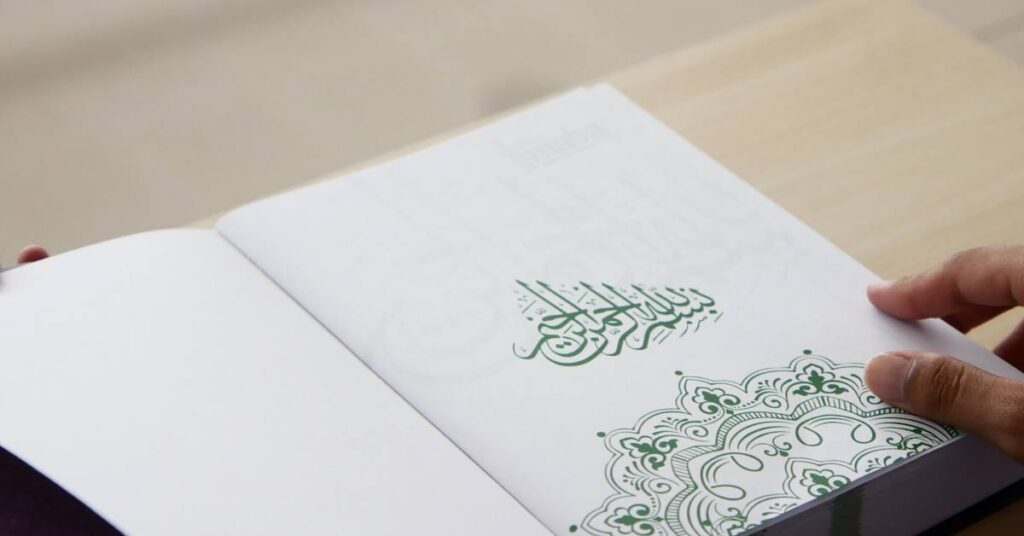Reciting the Qur’ān with proper Tajwīd is of utmost importance, yet unfortunately, it is often overlooked and not given the respect it deserves. Many people are unaware of the rules and significance of Tajwīd, which is why we have prepared a short article – adapted from the notes of Mawlānā Mizanur Rahman – on Tajwīd essentials highlighting our observations and points of focus when reciting taʿawwudh and tasmiyah. It is remarkable to consider the level of diligence and focus that is required even in just a few words, words that we repeat countless times throughout the day. We pray that this small effort will help to open our eyes, minds, and hearts to the significance of Tajwīd.
Tajwīd Essentials: Taʿawwudh – أعوذ بالله من الشيطان الرجيم
Aʿūdhu – أعوذ
- Read the hamzah (ء) clearly and give it its vocal right when pronouncing it (taḥqīq).
- Read the ḥarakah of hamzah (ء) (fatḥah) with an empty mouth (muraqqaq) as opposed to full mouth (mufakhkham).
- Do not elongate the sound of hamzah (ء); it is only one ḥarakah long.
- Differentiate between hamzah (ء) and ʿayn (ع). Hamzah (ء) is articulated from the bottom of the throat while ʿayn (ع) is articulated from the middle.
- Round the lips when pronouncing ʿayn (ع) because it bears a ḍammah.1The lips are engaged at five places only. They are four letters; ب، ف، م، و and one ḥarakah; ḍammah.
- Do not read the elongation due to the wāw sākinah (وْ) through the nose (khayshūm). Do this by fully engaging and rounding the lips to project the sound of ḍammah.
- Differentiate between dhāl (ذ) and ẓā’ (ظ). Although these letters are articulated from the same point; the tip of the tongue touching the edge of the central incisors, the sound of both letters are different. Dhāl (ذ) is empty mouth while ẓā’ (ظ) is full mouth.
- Round the lips when pronouncing dhāl (ذ) because it bears a ḍammah.
Billāhi – بالله
- Read the bā’ (ب) with force (shiddah), ensuring it is properly articulated.
- Read the kasrah of the bā’ (ب) and hā’ (ه) clearly. It should not be between fatḥah and kasrah so as to produce a sound such as ‘beh’ and ‘heh’.
- Do not read hā’ (ه) through the nose (khayshūm). This may occur in anticipation of the upcoming mīm (م).2Mīm (م) and nūn (ن) both have an element of ghunnah which is produced through the nose.
Min-ash Shayṭān – من الشيطان
- Read the kasrah of the mīm (م) clearly. It should not be between fatḥah and kasrah so as to produce a sound such as ‘meh’.
- Read the fatḥah of the nūn (ن) clearly.
- Do not engage the lips when pronouncing shīn (ش). They should not be expanded.
- Read the shaddah (ــّـ) of shīn clearly.
- Read yā’ sākinah (يْ) clearly. Yā’ (ي) has the quality of rikhwah which allows the sound of the letter to remain flowing. Therefore, the sound should not stop abruptly.
- Read the ṭā’ (ط) with a full mouth (mufakhkham) while avoiding any lip movement in doing so.
- Read the kasrah of the nūn (ن) clearly.
Ar-Rajīm – الرجيم
- Read the shaddah (ــّـ) of rā’ (ر) clearly.
- Read the rā’ (ر) with a full mouth (mufakhkham) at both instances.
- Avoid excessive takrīr in the rā’ (ر). Takrīr is the quality, when pronounced, the sound vibrates.
- Read the jīm (ج) with force (shiddah), ensuring it is properly articulated.
- Read the kasrah of the jīm (ج) clearly. It should not be between fatḥah and kasrah so as to produce a sound such as ‘jeh’.
- Do not read yā’ sākinah (يْ) through the nose. This may occur in anticipation of the upcoming mīm (م).
- Do not divert the sound of yā’ (ي) towards the end of the elongation (madd). Keep it consistent throughout.
- Read the mīm (م) with its quality of tawassuṭ; the sound should not flow excessively nor stop abruptly.
Tajwīd Essentials: Tasmiyah – بسم الله الرحمن الرحيم
Bismillāh – بسم الله
- Read the bā’ (ب) with force (shiddah), ensuring it is properly articulated.
- Read the kasrah of the bā’ (ب) mīm (م) and hā’ (ه) clearly. It should not be between fatḥah and kasrah so as to produce a sound such as ‘beh’, ‘meh’ and ‘heh’.
- Read the shaddah (ــّـ) of lām (ل) clearly.
- Read the lām (ل) with an empty mouth (muraqqaq) at both instances.
Ar-Raḥmān ni-r Raḥīm – الرحمن الرحيم
- Read the shaddah (ــّـ) of rā’ (ر) clearly.
- Read the rā’ (ر) with a full mouth (mufakhkham) at both instances.
- Avoid excessive takrīr in the rā’ (ر).
- Read the rā’ with its quality of tawassuṭ; the sound should not flow excessively nor stop abruptly.
- Do not read ḥā’ sākinah with a full mouth (mufakhkham). This may occur since the rā’ before it is full mouth (mufakhkham), thereby translating this thickness to the ḥā’ as well.
- Read the kasrah of the nūn clearly.
- Do not read yā’ sākinah (يْ) through the nose. This may occur in anticipation of the upcoming mīm (م).
- Do not divert the sound of yā’ (ي) consistent towards the end of the elongation (madd). Keep it consistent throughout.
- Read the mīm (م) with its quality of tawassuṭ.
In conclusion, understanding the correct application and method of reciting the Qur’ān is crucial. Taʿawwudh and tasmiyah serve as gatekeepers to the Qur’ān, making them critical aspects of our recitation. Use this article as a guide to identify and correct your mistakes, and take your recitation to the next level with our Tajwid course taught by Mawlana Muhammad Ahmad. Stay tuned for our upcoming article on common mistakes made in reciting Sūrah al-Fātiḥah and how to correct them to improve your recitation.
[Checked and Approved by Mawlānā Mizanur Rahman and Mawlānā Muhammad Ahmad]
Footnotes
- 1The lips are engaged at five places only. They are four letters; ب، ف، م، و and one ḥarakah; ḍammah.
- 2Mīm (م) and nūn (ن) both have an element of ghunnah which is produced through the nose.





1 thought on “Tajwid Essentials: Points of Focus in Taʿawwudh and Tasmiyah”
What a great resource for anyone looking to improve their recitation of the Qur’an! Its well-written and provides detailed explanations and helpful examples, making it easy to understand and implement the correct pronunciation of ta’awwudh and tasmiyah. I appreciate how the author and those involved highlights the importance of these essential elements and provides practical tips to help readers improve their recitation. Overall, an excellent article that I would highly recommend to anyone looking to improve their tajwid skills. Great job on providing such a valuable resource for the Muslim community.